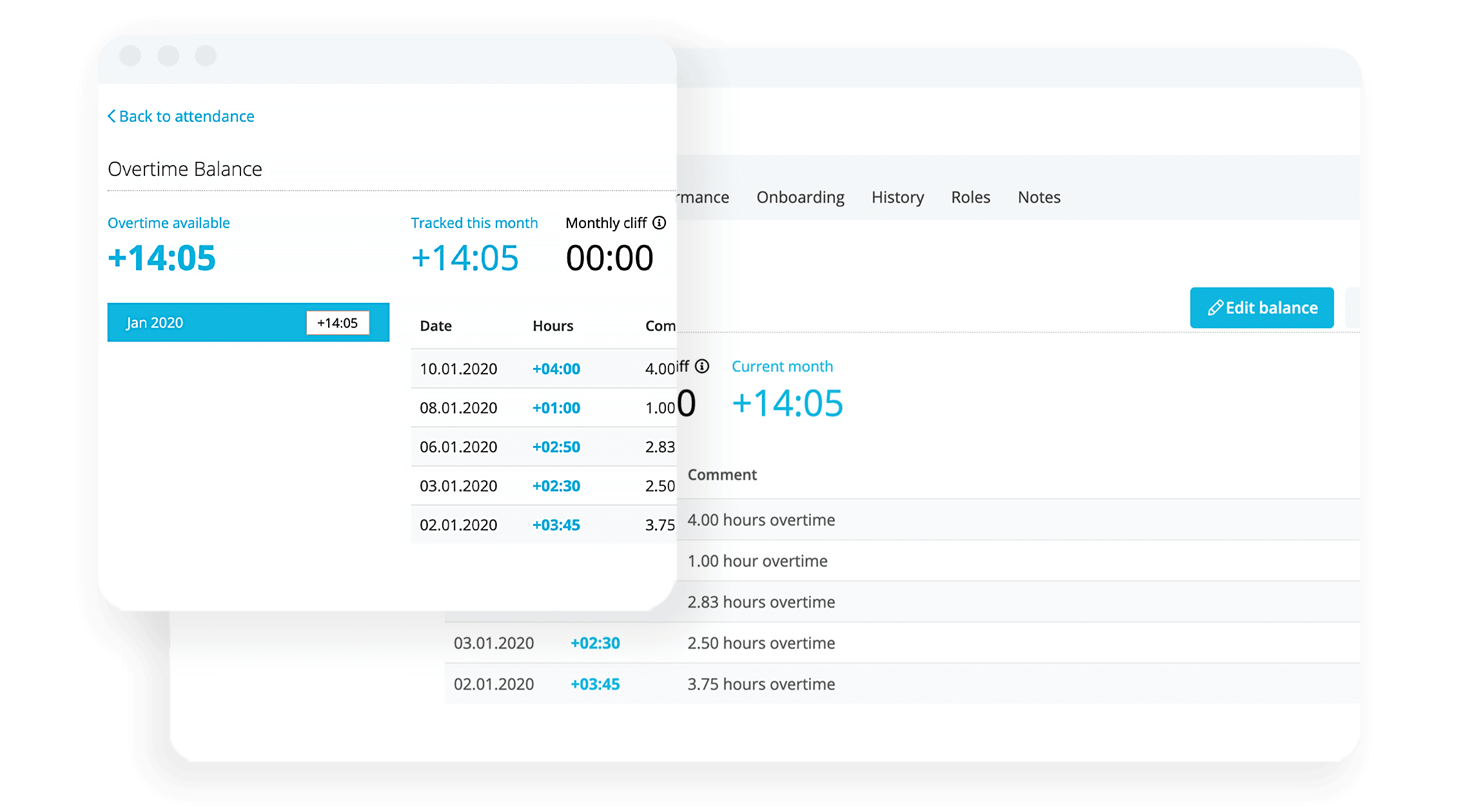Latest Blog Posts
Are You Calculating Overtime Correctly?

Contents
- 1What Is Overtime In The UK?
- 2Overtime Calculator UK: How Is Overtime Calculated?
- 3The Guide To Calculating Overtime For UK EmployeesWhat Does UK Law Say About Overtime?
- 4Why Is Calculating Overtime Important?
- 5HR Tips for Documenting Legally-Worked Overtime
- 6Overtime Calculations: Key Situations & Considerations
- 7Overtime Calculations With HR Software
What Is Overtime In The UK?
Overtime in the UK essentially boils down to a worker, typically an hourly one (but not always), working hours beyond what is stipulated in their working contract. This can include both work that is completed outside ‘normal’ working hours, or when an employee works more hours than required or agreed upon in writing.
What Is Time And A Half?
A somewhat related concept to overtime, time and a half is used to incentivize workers to come into work on a day when they would otherwise not be expected to. This could include holidays or other particularly important times of the year, and it means that they are paid 1.5 times their normal rate.
Does Your Company Need An Overtime Calculator?
An overtime calculator is the tool, device, or mechanism that calculates how much overtime has occurred during a certain period. It is used to help employees and employers calculate what overtime is paid, and at what rate, so everyone is clear about overtime pay.
Overtime Calculator UK: How Is Overtime Calculated?
While an HR software can help do this automatically for every employee in your organization, here is a quick way to understand how to calculate overtime for your employees:
Step | Direction |
|---|---|
Step One | Determine an employee's standard pay in a weekly or monthly period. |
Step Two | Add the number of hours of overtime worked, per period, at their overtime rate (1.5, for instance). |
Step Three | Combine the two figures to result in the full amount payable to an employee. |
Let’s make it a bit more tangible with an example, though:
Standard Pay (Weekly) | £1,950 |
|---|---|
Hours Worked (At Overtime Rate) | 10 Hours (£19.50 x 1.5) |
Total Pay (Weekly) | £2,242.50 |
Is Calculating Overtime Difficult?
As you can see from the above equation, not especially! It’s why you might not even need an overtime calculator, but what you truly need is a way to effectively and reliably track overtime in your organization.
So, ask yourself some of the following questions about how you currently track overtime:
How do employees currently input their hours?
How would you know that they worked overtime?
Do you have a way to square what is in their contract with how much they should be paid?
There are two factors at play here: tracking attendance and managing crucial employee data.
When you have both, you may not even need an overtime calculator, because an effective HR software can handle the entire process on your team’s behalf.
The Guide To Calculating Overtime For UK EmployeesWhat Does UK Law Say About Overtime?
"An employer may offer overtime to cope with an increase in demand for their products or services", says acas, however, according to NIDirect, employers in the UK have no legal responsibility to pay for working extra hours (unless this is documented in the employee contract).
There is also no minimum statutory level of overtime pay, as long as an employee’s average pay rate doesn’t fall below the National Minimum Wage. However, the rules on working overtime in the UK are slightly different from the rest of the world.
As SmallBusiness.co.uk explains, “This contrasts markedly with other labor markets in the west. For example in Germany, employees accrue overtime as time in lieu. In the United States, employees working more than 40 hours must receive overtime payments in line with the Fair Labour Standards Act”.
Track your teams' time seamlessly

Enable your employees to enter their working hours in an efficient, legally compliant and secure system. See working hours at a glance across your company.
Get Smarter Time TrackingBeware, though… the law, sometimes known as the working time directive or the working time regulations does stipulate that employees cannot work more than 48 hours a week on average (unless they opt-out). You can find an example of the opt-out agreement by clicking this helpful link.
Signing an opt-out clause does not require employees to work more than 48 hours a week forever, though.
The Citizens Advice Bureau says that if they’re having mental or physical health problems because of overwork, or are being asked to do more than is realistic to achieve in their normal hours they can cancel their opt-out agreement by giving at least 7 days’ notice in writing.
As an employer, you can ask them for a longer notice period to cancel this opt-out clause (up to 3 months). That is, if you have put that clause in their contract. And, you might actually be able to reduce their pay in some circumstances if they have opted out and then choose to cancel it.
Why Is Calculating Overtime Important?
Consider this: Are your employees working a fair number of hours each week?
In May 2020, Metro reported on research commissioned by LinkedIn in partnership with The Mental Health Foundation. It revealed that 25% of the 2,000 UK adults working from home during Covid-19 felt pressured to respond more quickly and remain available online for longer than they normally would, with one in eight (12%) now signing in before 7 am and 18% still working after 7 pm.
As an HR leader, it is critical to take care of your people. Working too many hours can lead to stress, mental health issues, and even burnout. After all, there is a good reason why the working time directive is in place.
Not All Overtime Is Bad Overtime
However, not all overtime is bad overtime. Some industries expect and require employees to work overtime.
The Covid-19 heroes, NHS heroes, do work a lot of compulsory overtime. And, many employees volunteer to work overtime to boost their own income.
As is the case with most employment-related activities: It’s all about what’s in their contract. HR leaders may very well require employees to work overtime, and that is perfectly acceptable.
HR Tips for Documenting Legally-Worked Overtime
The most important thing for HR to consider with regards to employee overtime is documenting whatever is agreed on.
Here’s an example: Employees choosing to work more than the legally allowed 48 hours. Make sure the opt-out agreement is in every relevant employee’s contract. Don’t forget, though, that it is not a requirement to sign this.
In essence, it is important to ensure that every relevant employee’s contract includes details of:
Contract Specification | What It Means |
|---|---|
Overtime Pay Rates | The rate at which overtime is compensated (1.5x, for example) |
Overtime Pay Process | How pay is worked out (hours, conditions, etc.) |
Documentation | How employees document overtime worked |
Payment | When and how employees are paid for overtime |
Allow Employees To Easily Track Overtime

Personio calculates salaries and overtime, based on employee working hour schedules, for clean, simple, and easily-actionable processes, every time.
Personio calculates salaries and overtime, based on employee working hour schedules, for clean, simple, and easily-actionable processes, every time.
Overtime Calculations: Key Situations & Considerations
TOIL? Holiday Pay? What are some of the major overtime considerations you need to make as an employer? Let’s try on some of these for size…
What About Time Off in Lieu (TOIL)?
Some companies choose to offer ‘time off in lieu’ (TOIL) instead of overtime. Rocketlawyer says, “This means that the employee will not get paid for the extra work they do, but they can take hours off in addition to their annual leave instead”.
According to NIDirect, employers and employees agree the time when individuals take TOIL. In general, it is normally at a time that suits the employer.
You can read our full guide to TOIL by clicking here.
What About Holiday Allowance and Overtime?
In short, holiday pay calculation is much wider than basic pay. According to acas, “recent court decisions have indicated that all overtime worked should be included when calculating a worker’s statutory holiday pay entitlement”.
This is a topic we have covered in great detail already. You can find out more by clicking this link.
What About Furlough Pay and Overtime?
For a thorough overview on this subject, take a look at the Thomson Reuters Practical Law article on calculating furlough pay under the Coronavirus Job Retention Scheme. In it, you can see the inclusion of overtime for the purposes of calculating an employee’s regular salary or wages. This also addresses issues related to overtime and fixed-rate employees.
Overtime Calculations With HR Software
Once HR has dealt with the ins and outs of contracts, opt-ins/opt-outs, TOIL, and other overtime pay-related issues, calculating overtime pay comes next. Actually, working it out is quite simple.
As we mentioned earlier: Add up the number of overtime hours worked and multiply that by the overtime pay rate.
An advanced HR solution can make it really easy to calculate employees’ overtime pay within the same system you already use to track employee-related documents or payroll.
For example, Personio allows you not only to track attendances but to record and compensate for any overtime worked by your employees. Regardless of whether your business pays for overtime or not if it’s important for you to track when attendees are working sooner or later, it’s wise to invest in an effective and reliable attendance tracking tool.

